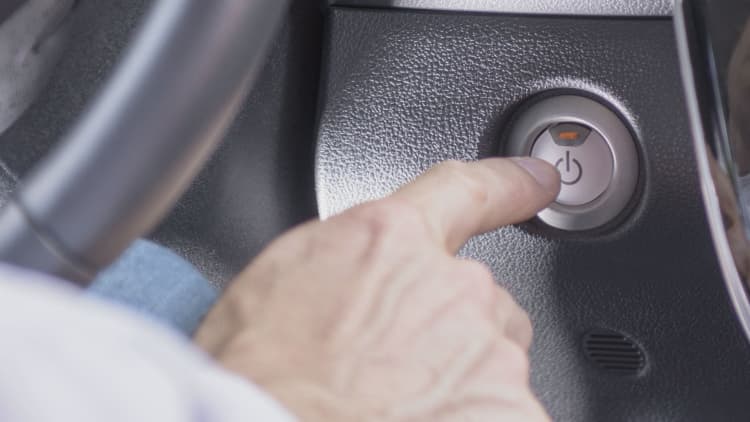
Hoping to increase the appeal of their battery-electric vehicles, automakers have begun rolling out an assortment of "long-range" models, such as the Tesla Model 3, Chevrolet Bolt EV, Jaguar I-Pace and Nissan Leaf Plus.
Under ideal conditions, these products can deliver more than 200 miles per charge and, in some cases, even 300. But as many owners discovered last week as winter storms slammed much of the country, cold weather does not qualify as "ideal." A new AAA study finds that when the thermometer dropped to 20 degrees Fahrenheit, range fell by an average of 41 percent on the five models it tested.
"We found that the impact of temperature on EVs is significantly more than we expected," said Greg Brannon, AAA's director of automotive engineering.
Some EV drivers — including this correspondent — recently found that range can drop by half when the mercury tumbles into negative territory. The AAA study appears to be the first to have used standard, repeatable methodology to confirm the problem and compare the effect of winter temperatures on different models.
Several surprises emerged from the research, according to Brannon, starting with the fact that the impact on range was pretty much uniform among the cars tested: the BMW i3s, the Chevrolet Bolt EV, the Nissan Leaf, the Tesla Model S and the Volkswagen e-Golf.
"It's something all automakers are going to have to deal with as they push for further EV deployment because it's something that could surprise consumers," said Brannon.
Different factors can affect the loss of range, he and other experts have noted. Simply turning on the electric vehicles AAA studied in 20 degree weather revealed a 12 percent loss in range. On a vehicle like the Chevy Bolt, with an EPA rating of 238 miles per charge, that would drop range to 209 miles. But that part of the test assumed operating the vehicle with cabin heat and seat heaters turned off.
Brannon said using climate control revealed an even bigger surprise: Range dipped by an average 41 percent — which would bring an EV like the Bolt down to just 140 miles per charge.
The problem is that unlike a car with an internal combustion engine that can warm the cabin with waste heat, EVs have to tape into their batteries to power the climate control system.
Part of the problem, he said, is that "lithium-ion batteries like the same sort of temperatures that we do, around 70 degrees."
Much below that and the chemistry that's used to store energy runs into various problems. Among other things, battery components develop increased resistance that limits how much power they can hold, as well as how fast a battery pack can be charged or discharged, said Timothy Grewe, chief engineer for electric propulsion systems at General Motors.
Grewe has experienced sharp reductions in the range of his own Chevy Bolt, but he also said there are ways to limit the impact of cold weather. That includes storing a battery car in a garage, preferably one that's heated. And wherever it is parked, it helps to keep the EV plugged in. Onboard electronics will prevent overcharging. But many battery vehicles are programmed to use some of the energy from the grid to keep the battery pack warm, improving its efficiency.
Motorists are also advised to "precondition" their EVs, Grewe and Brannon said. That means heating up the cabin while still connected to the grid, rather than drawing energy from the battery pack. Most new battery-electric vehicles have custom smartphone apps that allow a driver to switch on cabin heat remotely when plugged in. Commuters can even preprogram the system to automatically start at a particular time of day.
While cold weather is especially hard on range, batteries also don't like hot weather, said Brannon. "Much like when it's cold, in hot weather EVs suffer some decrease in range, but not as much as in the cold."
The AAA study found range fell 4 percent from EPA numbers at 95 degrees. But, again, that number was assuming the motorist didn't mind sweating. Turn the climate control system down to 70 degrees, AAA found and range fell by 17 percent.
Tesla emailed a statement that disputed AAA's findings, saying the report exaggerates the impact that cold weather has on its electric vehicles' range. The company didn't provide data saying how much range is lost in cold temperatures.
"Based on real-world data from our fleet, which includes millions of long trips taken by real Model S customers, we know with certainty that, even when using heating and air conditioning, the average Model S customer doesn't experience anywhere near that decrease in range at 20 degrees Fahrenheit," the company said in a statement. "And the decrease in range at 95 degrees Fahrenheit is roughly 1 percent."
One thing that EVs and conventional vehicles have in common is that energy efficiency — whether measured by range or miles per gallon — can be affected by a variety of factors. These can include your driving style, as well as the terrain.
Do a lot of hill climbing and you're going to use energy faster. EVs, however, are especially sensitive to any accessory drawing power, whether the car's climate control or even headlights, meaning that driving at night, whatever the weather, will hurt range.

